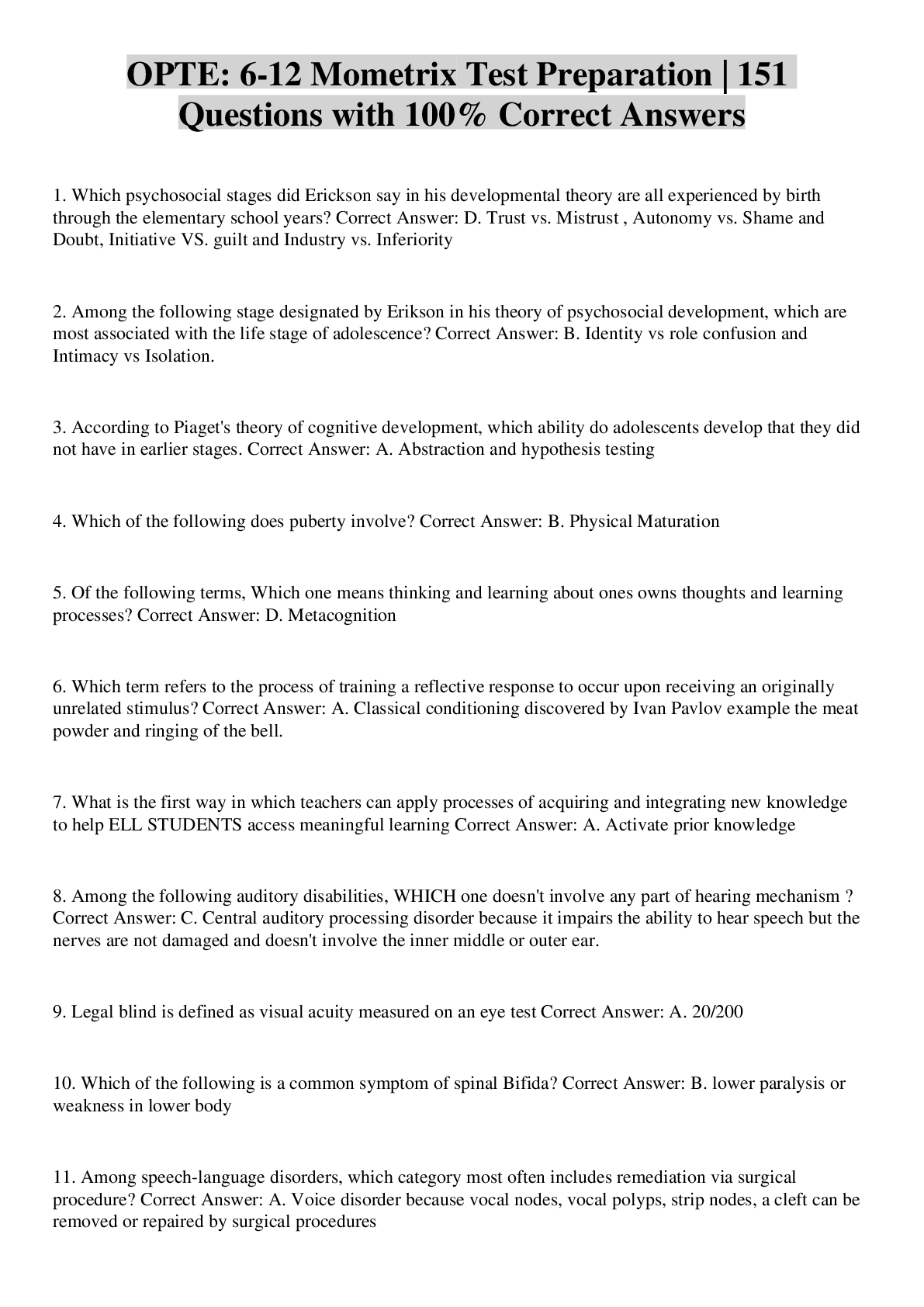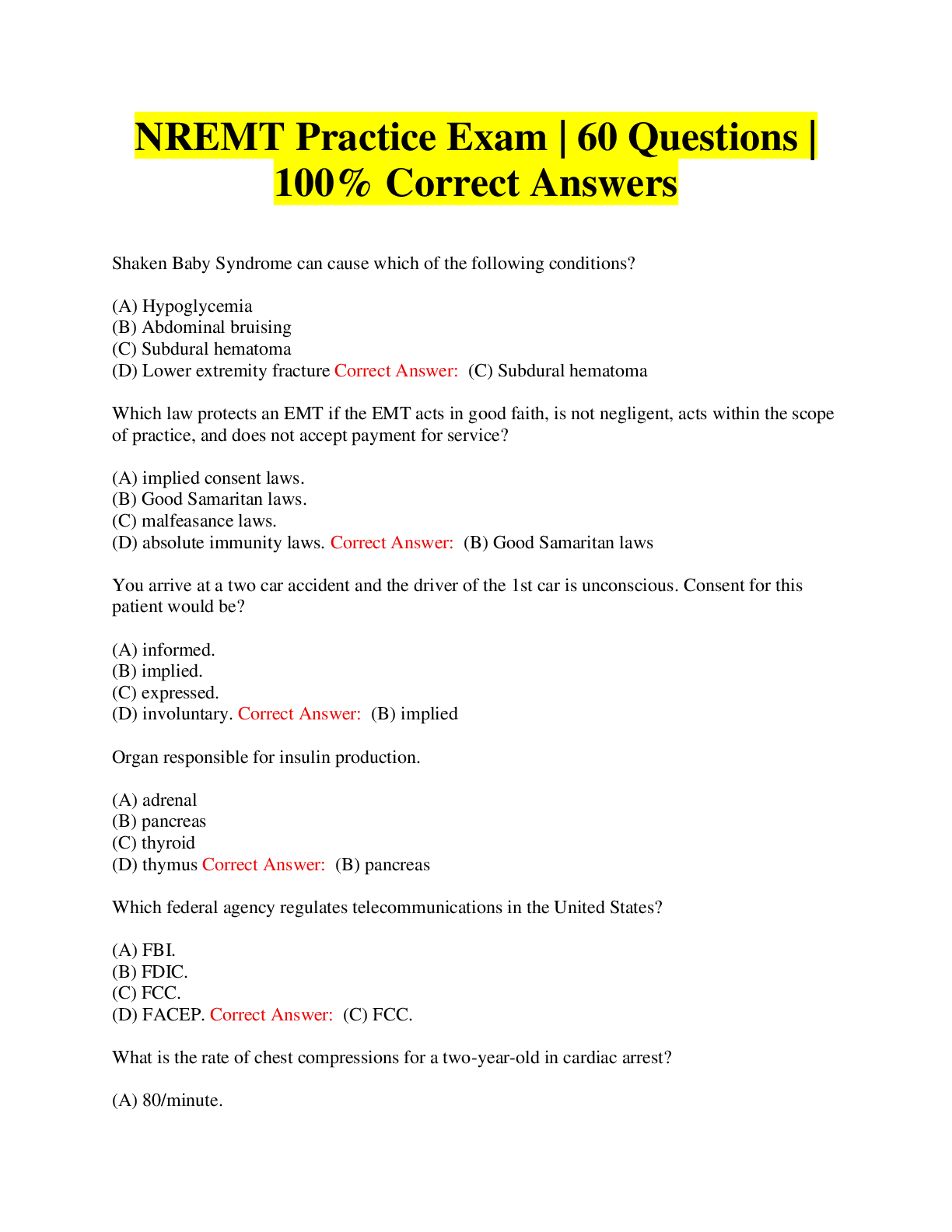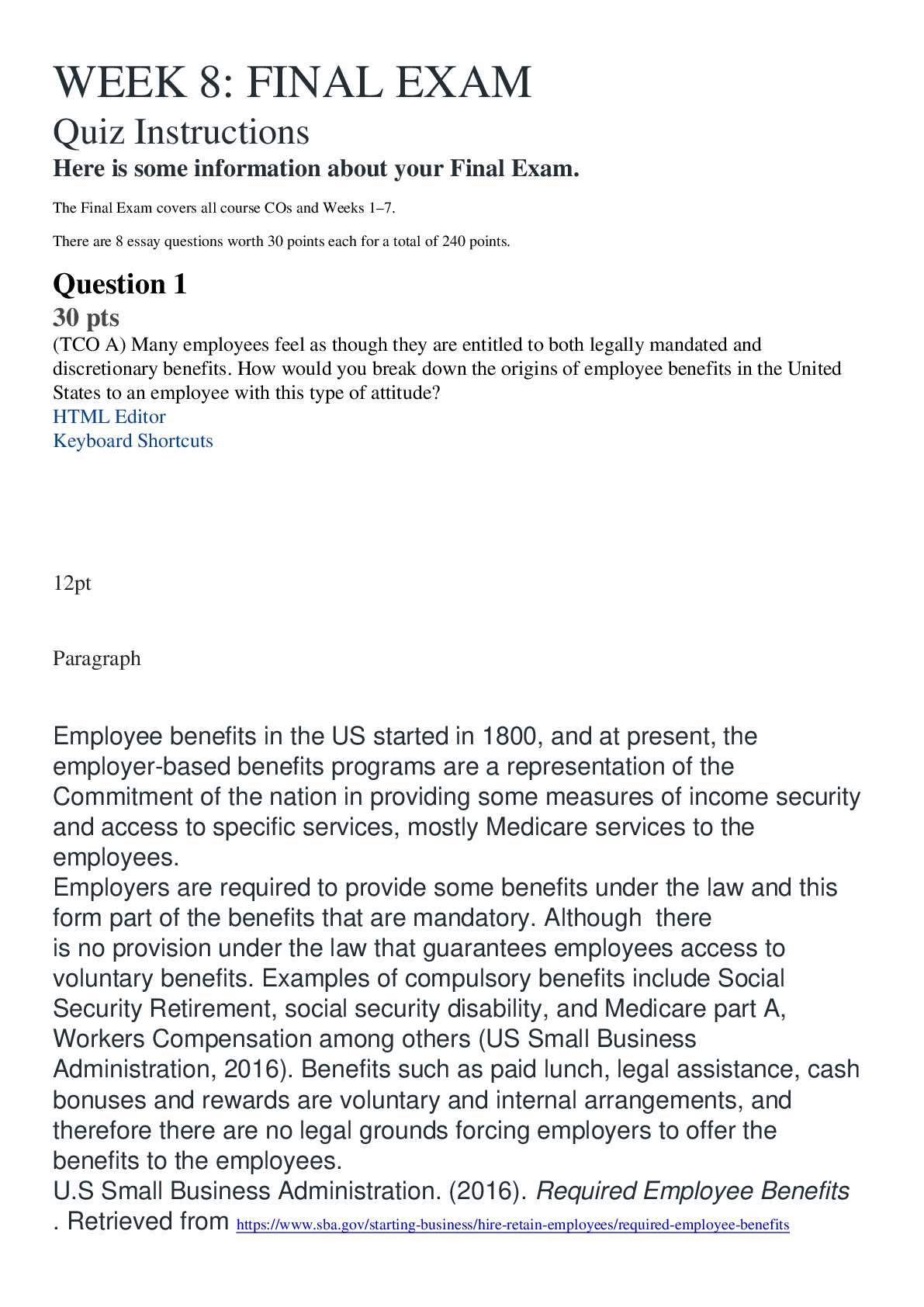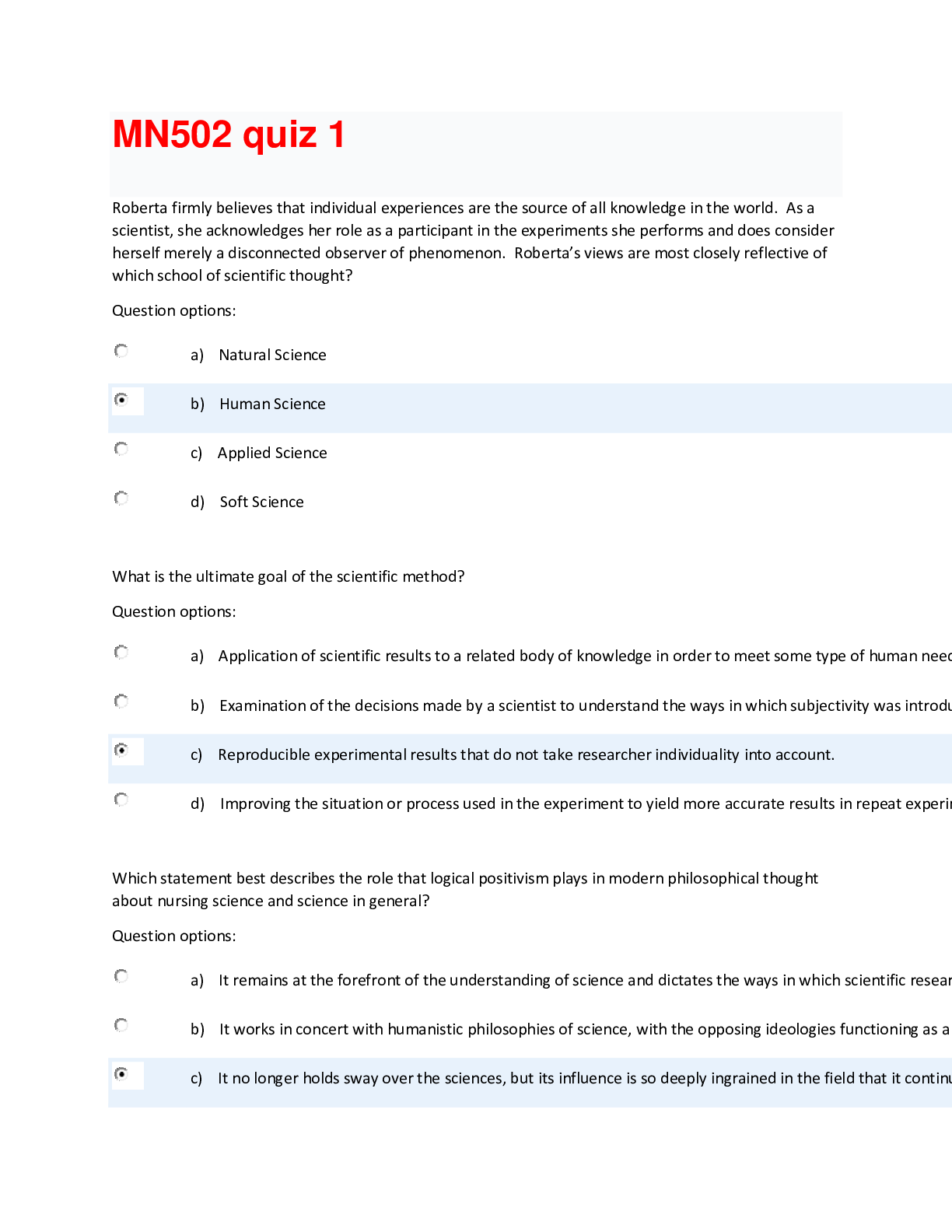Health Care > EXAM > USMLE STEP 1 Pharmacology QUESTIONS AND ANSWERS 100% GRADED A (All)
USMLE STEP 1 Pharmacology QUESTIONS AND ANSWERS 100% GRADED A
Document Content and Description Below
USMLE STEP 1 Pharmacology What are the major functions of the α1 receptor? Correct Answer: Increase vascular smooth muscle contraction, increase pupillary dilator muscle contraction (mydriasis), ... increase intestinal and bladder sphincter muscle contraction What are the major functions of the α2 receptor? Correct Answer: Decrease sympathetic outflow, decrease insulin release, decrease lipolysis, increase platelet aggregation, decrease aqueous humor production What are the major functions of the β1 receptor? Correct Answer: Increase heart rate, increase contractility, increase renin release, increase lipolysis What are the major functions of the β2 receptor? Correct Answer: Vasodilation, bronchodilation, increase lipolysis, increase insulin release, decrease uterine tone (tocolysis), ciliary muscle relaxation, increase aqueous humor production What are the major functions of the M1 receptor? Correct Answer: CNS, enteric nervous system What are the major functions of the M2 receptor? Correct Answer: Decrease heart rate and contractility of atria What are the major functions of the M3 receptor? Correct Answer: Increase exocrine gland secretions (e.g., lacrimal, salivary, gastric acid), increase gut peristalsis, increase bladder contraction, increase bronchoconstriction, pupillary sphincter muscle contraction (miosis), ciliary muscle contraction (accommodation) What are the major functions of the D1 receptor? Correct Answer: Relaxes renal vascular smooth muscle What are the major functions of the D2 receptor? Correct Answer: Modulates transmitter release, especially in the brain What are the major functions of the H1 receptor? Correct Answer: Increase nasal and bronchial mucus production, increase vascular permeability, contraction of bronchioles, pruritis, pain What are the major functions of the H2 receptor? Correct Answer: Increase gastric acid secretion What are the major functions of the V1 receptor? Correct Answer: Increase vascular smooth muscle contraction What are the major functions of the V2 receptor? Correct Answer: Increase H2O permeability and reabsorption in collecting tubules of kidney (V2 is found in the "2" kidneys) What receptors are associate with Gq? Correct Answer: H1, α1, V1, M1, and M3 What receptors are associated with Gs? Correct Answer: H2, B1, B2, V2, D1 What receptors are associated with Gi? Correct Answer: M2, α2, D2 Bethanechol Correct Answer: -Direct cholinergic agonist -Activates bowel and bladder smooth muscle -Used in postoperative and neurogenic ileus -Resistant to AChE Carbachol Correct Answer: -Direct cholinergic agonist -Carbon copy of acetylcholine -Constricts pupils and relieves intraocular pressure in glaucoma Methacholine Correct Answer: -Direct cholinergic agonist -Stimulates muscarinic receptors in airways when inhaled -Used as a challenge test for diagnosis of asthma Pilocarpine Correct Answer: -Direct cholinergic agonist -Contracts ciliary muscle of eye (open angle glaucoma), contracts pupillary sphincter (closed angle glaucoma) -Potent stimulator of sweat, tears and saliva -AChE resistant Donepezil Correct Answer: -Anticholinesterse - increases ACh -Alzheimer disease Galantamine Correct Answer: -Anticholinesterse - increases ACh -Alzheimer disease Rivastigmine Correct Answer: -Anticholinesterse - increases ACh -Alzheimer disease Edrophonium Correct Answer: -Anticholinesterse - increases ACh -Historically used to diagnose myasthenia gravis (MG is now diagnosed by anti-AChR Ab test. Neostigmine Correct Answer: -Anticholinesterse - increases ACh -Used in postoperative and neurogenic ileus and urinary retention, myasthenia gravis, and postoperative reversal of neuromuscular junction blockade Physostigmine Correct Answer: -Anticholinesterse - increases ACh -Used in anticholinergic toxicity -Crosses the blood-brain barrier (CNS) Pyridostigmine Correct Answer: -Anticholinesterse - increases ACh -Increases muscle strength -Used in myasthenia gravis (long acting) -Does not penetrate CNS Atropine Correct Answer: -Muscarinic antagonist -Used in bradycardia and for ophthalmic applications -Also used as antidote for cholinesterase inhibitor poisoning -Actions include increase pupil dilation, cycloplegia, decreased airway secretions, decreased acid secretions, decreased gut motility, decreased bladder urgency in cystitis -Toxicity: increased body temp (due to decreased sweating), rapid pulse, dry mouth, dry and flushed skin, cycloplegia, constipation, disorientation; -Can cause acute angle-closure glaucoma in elderly (due to mydriasis), urinary retention in men with prostatic hyperplasia, and hyperthermia in infants -See also homatropine and tropicamide Benztropine Correct Answer: -Muscarinic antagonist -Works in CNS -Used in Parkinson disease and acute dystonia Glycopyrrolate Correct Answer: -Muscarinic antagonist -Parental use: preoperative use to reduce airway secretions -Oral use: drooling, peptic ulcer Hyoscyamine Correct Answer: -Muscarinic antagonist -Antispasmodics for IBS Dicyclomide Correct Answer: -Muscarinic antagonist -Antispasmodics for IBS Ipratropium Correct Answer: -Muscarinic antagonist -Used in COPD and asthma Tiotropium Correct Answer: -Muscarinic antagonist -Used in COPD and asthma Oxybutynin Correct Answer: -Muscarinic antagonist -Reduced bladder spasms and urge urinary incontinence Solifenacin Correct Answer: -Muscarinic antagonist -Reduced bladder spasms and urge urinary incontinence Tolterodine Correct Answer: -Muscarinic antagonist -Reduced bladder spasms and urge urinary incontinence Scopalamine Correct Answer: -Muscarinic antagonist -Motion sickness Tetrodotoxin Correct Answer: -Poisoning can result from ingestion of poorly prepared puffer fish (exotic sushi) -Highly potent toxin that binds fast voltage-gated Na+ channels in cardiac and nerve tissue, preventing depolarization - blocks action potential without changing resting potential (same mechanism as Lidocaine) -Causes nausea, diarrhea, paresthesias, weakness, dizziness, loss of reflexes. -Treatment is primarily supportive. Ciguatoxin Correct Answer: -Consumption of reef fish (e.g. barracuda, snapper, eel...) -Causes ciguatera fish poisoning. -Opens Na+ channels causing depolarization. Symptoms easily confused with cholinergic poisoning. -Temperature-related dysesthesia (e.g., "cold feels hot; hot feels cold") is regarded as a specific finding of ciguatera. -Treatment is primarily supportive. Scombroid poisoning Correct Answer: -Caused by consumption of dark-meat fish (e.g., bonito, mackerel, mahi-mahi, tuna) improperly stored at warm temperature. -Bacterial histidine decarboxylase converts histidine to histamine. Histamine is not degraded by cooking. -Acute-onset burning sensation of the mouth, flushing of face, erythema, urticaria, pruritus, headache. May cause anaphylaxis-like presentation (i.e., bronchospasm, angioedema, hypotension). -Frequently misdiagnosed as allergy to fish. -Treat supportively with antihistamines; if needed, antianaphylactics (e.g., bronchodilators, epinephrine). Albuterol Correct Answer: -β2 > β1 direct agonist -Acute asthma Salmterol Correct Answer: -β2 > β1 direct agonist -Long term asthma or COPD control Dobutamine Correct Answer: -β1 > β2, α direct agonist -Uses: heart failure (HF) (inotropic > chronotropic), cardiac stress testing. Dopamine Correct Answer: -D1 = D2 > β > α direct agonist -Uses: unstable bradycardia, HF, shock; inotropic and chronotropic α effects predominate at high doses. Epinephrine Correct Answer: -β > α direct agonist -Uses: anaphylaxis, asthma, open-angle glaucoma; α effects predominate at high doses. Significantly stronger effect at β2-receptor than norepinephrine. Isoprterenol Correct Answer: -β1 = β2 direct agonist -Uses: electrophysiologic evaluation of tachyarrhythmias. Can worsen ischemia Norepinephrine Correct Answer: -α1 > α2 > β1 direct agonist -Hypotension (butrenal perfusion). Significantly weaker effect at β2-receptor than epinephrine. Phenylephrine Correct Answer: -α1 > α2 direct agonist -Uses: hypotension (vasoconstrictor), ocular procedures (mydriatic), rhinitis (decongestant) Amphetamine Correct Answer: -Indirect general sympathetic agonist -reuptake inhibitor; also releases stored catecholamines -Narcolepsy, obesity, ADHD. Cocaine Correct Answer: -Indirect general sympathetic agonist -Reuptake inhibitor -Causes vasoconstriction and local anesthesia. -Never give β-blockers if cocaine intoxication is suspected (can lead to unopposed α1 activation and extreme hypertension). Ephedrine Correct Answer: -Indirect general sympathetic agonist -Releases stored catecholamines -Nasal decongestion, urinary incontinence, hypotension. Norepinephrine vs. isoproterenol Correct Answer: -Norepinephrine increases systolic and diastolic pressures as a result of α1-mediated vasoconstriction causing increased in mean arterial pressure and reflex bradycardia. -However, isoproterenol (no longer commonly used) has little α effect but causes β2-mediated vasodilation, resulting in decreased mean arterial pressure and increased heart rate through β1 and reflex activity. Clonidine Correct Answer: -α2-agonist -Uses: hypertensive urgency (limited situations); does not decrease renal blood flow; ADHD, Tourette syndrome -Toxicity: CNS depression, bradycardia, hypotension, respiratory depression, miosis α-methyldopa Correct Answer: -α2-agonist -Used for hypertension in pregnancy -Toxicity: Direct Coombs ⊕ hemolysis, SLE-like syndrome Phenoxybenzamine Correct Answer: -Nonselective α-blocker -Irreversible -Used preoperatively for pheochromocytoma to prevent catecholamine (hypertensive) crisis -Toxicity: orthostatic hypotension, reflex tachycardia Phentolamine Correct Answer: -Nonselective α-blocker -Give to patients on MAO inhibitors who eat tyramine containing foods -Toxicity: orthostatic hypotension, reflex tachycardia Prazosin Correct Answer: -Selective α1-blocker -Uses: urinary symptoms of BPH; PSTD -Hypertension -Toxicity: 1st-dose orthostatic hypotension, dizziness, headache Terazosin Correct Answer: -Selective α1-blocker -Uses: urinary symptoms of BPH; -Hypertension -Toxicity: 1st-dose orthostatic hypotension, dizziness, headache Doxazosin Correct Answer: -Selective α1-blocker -Uses: urinary symptoms of BPH; -Hypertension -Toxicity: 1st-dose orthostatic hypotension, dizziness, headac [Show More]
Last updated: 2 years ago
Preview 1 out of 71 pages

Buy this document to get the full access instantly
Instant Download Access after purchase
Buy NowInstant download
We Accept:

Reviews( 0 )
$16.50
Can't find what you want? Try our AI powered Search
Document information
Connected school, study & course
About the document
Uploaded On
Sep 14, 2022
Number of pages
71
Written in
Additional information
This document has been written for:
Uploaded
Sep 14, 2022
Downloads
0
Views
39

























